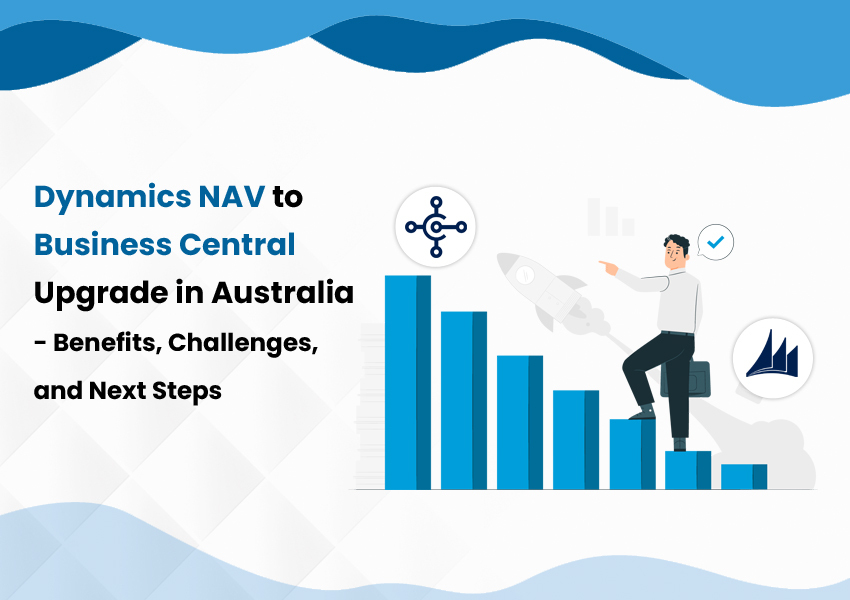Blog
Dynamics NAV to Business Central Upgrade in Australia – Benefits, Challenges, and Next Steps

Upgrading from Dynamics NAV to Business Central (BC) can be daunting, but the benefits are worth it. Business Central is a cloud-based solution that offers many features and functionalities, including financial management, supply chain management, project management, and more.
In this blog post, we will discuss the benefits of upgrading to Business Central, the challenges you may face, and the next steps you can take to ensure a successful upgrade.
What are the Benefits of Upgrading to Business Central?
According to a Microsoft-commissioned study by Forrester Consulting, companies that migrated to Business Central saw a 23% increase in productivity and a 20% reduction in time spent on manual data entry.
Cloud-Based Solution
Business Central is a cloud-based solution, which means it is accessible from anywhere, at any time, as long as you have an internet connection. Through this feature, businesses with remote teams can ensure continuous contact as it enables collaboration and access to real-time data. Furthermore, with the cloud-based system, companies no longer need to maintain on-premise hardware and software, reducing IT costs significantly.
Improved Functionality
Dynamics NAV to BC upgrade helps to improve functionality. It includes advanced analytics, AI-powered insights, and advanced reporting capabilities. With improved functionality, businesses can make informed decisions after gaining insights into their operations. The user interface is also more modern and intuitive, making it easier for employees to navigate and use the system.
Reduced IT Costs
After you decide to upgrade from Dynamics NAV to Business Central, it eliminates the need for on-premise software, thus reducing IT costs. It also eliminates the need for IT staff to manage the infrastructure, which frees up time for other essential tasks. This means businesses can focus on core business activities instead of worrying about IT infrastructure.
Automatic Upgrades
Business Central is a cloud-based solution constantly updated with new features and functionalities. These upgrades are automatic and seamless, so businesses do not need to worry about downtime or disruption. Thus, businesses always use the latest software version and have access to the latest features and functionalities.
Scalability
After migrating to the cloud-based Dynamics Business Central, you’ll realize that the software is highly scalable and it can grow with your business. Whether your business is small or large, Business Central can accommodate your needs. All in all, the business will not need to worry about outgrowing their ERP solution and going through the process of upgrading again.
What are the Possible Challenges You Might Face While Upgrading to Business Central?
Data Migration
One of the biggest challenges of upgrading to Business Central is data migration. Businesses need to ensure that all their data is transferred accurately and securely from Dynamics NAV to Business Central. This process can be time-consuming and complex, particularly for businesses with large volumes of data.
Customizations
The MSDynamicsWorld Podcast: Managing Customizations and Extensions in Business Central – This episode explores the process of managing customizations and extensions in Business Central and offers advice for minimizing disruptions during the upgrade process.
Many businesses have customized their Dynamics NAV solutions to meet their unique requirements. Dynamics NAV to BC upgrade may require changes to these customizations or the development of new ones.
Training
Upgrading to Business Central may require training for employees who need to become more familiar with the new system. Providing extensive training can take time and effort.
Third-Party Integrations
Businesses may have third-party integrations that are not compatible with Dynamics Business Central. This issue may require firms to seek new solutions or develop new integrations.
What’s Next After Upgrading From Dynamics NAV to Business Central?
Evaluate Your Current Solution
The first step in upgrading to Business Central is to evaluate your current solution. Identify the features and functionalities that are most important to your business and assess whether Business Central can meet these requirements.
Plan Your Migration
Once you have evaluated your current solution, it is time to plan your migration. This process should include data migration, customization updates, and training requirements. You may also need to consider the impact of the upgrade on your business operations.
Engage a Partner
Upgrading to Business Central can be complex and time-consuming, particularly for businesses with limited IT resources. Engaging a partner can ensure a smooth and successful upgrade. A Microsoft Dynamics NAV consultant can provide expertise in data migration, customization, and training and can help to minimize disruption to business operations.
Test Your Solution
Before going live with Business Central, it is essential to test your solution thoroughly. This process should include testing data migration, customizations, and integrations. Training employees on the new system and ensuring they are comfortable using it is also important.
Go Live and Monitor
Once you have successfully tested your solution, it is time to go live with Business Central. Monitoring the system closely in the initial stages is crucial to ensure that everything is running smoothly. You may also need to make additional customizations or integrations based on your business needs.
Take Advantage of New Features
Business Central offers a range of new features and functionalities that were not available in Dynamics NAV. As you start using the new system, exploring these features and taking advantage of them to improve your business operations is important.
Ensure Ongoing Support
Upgrading to Business Central is a process that takes time. The system will require ongoing support and maintenance to ensure that it continues to meet your business needs. Working with your partner to establish an ongoing support plan and ensure that your system is regularly updated with new features and functionalities is important.
To Sum Up
Upgrading from Dynamics NAV to Business Central can be complex, but the benefits are worth it. Business Central is a cloud-based solution that offers improved functionality, reduced IT costs, and integration with other Microsoft products. However, while undergoing the upgrade process, there might be several challenges that you might face. But rest assured, a Microsoft Dynamics NAV consultant like DynamicsSmartz can help you upgrade seamlessly.
Categories
- Upgrade
- United States
- United Arab Emirates
- Power BI
- Power Automate
- Partner Program
- Office 365
- Migration
- Industry Updates And Events
- Implementation
- Dynamics SL
- Dynamics NAV
- Dynamics GP
- Dynamics Business Central
- Dynamics 365 for Sales
- Dynamics 365 Field Service
- Dynamics 365
- CRM and ERP
- Construction365
- Australia
- Artificial Intelligence
Recent Posts
- Microsoft Dynamics 365: The Backbone of Australia’s Finance and Supply Chain Excellence
- Copilot AI for Different Industries in D365 (2025 Update): Transforming Future
- Microsoft Dynamics 365 vs Power Apps: A Fresh Comparison for 2025
- Why Sales Processes Matter in Dynamics 365 CRM
- Dynamics 365 Sales vs Customer Service: What are the key differences?








